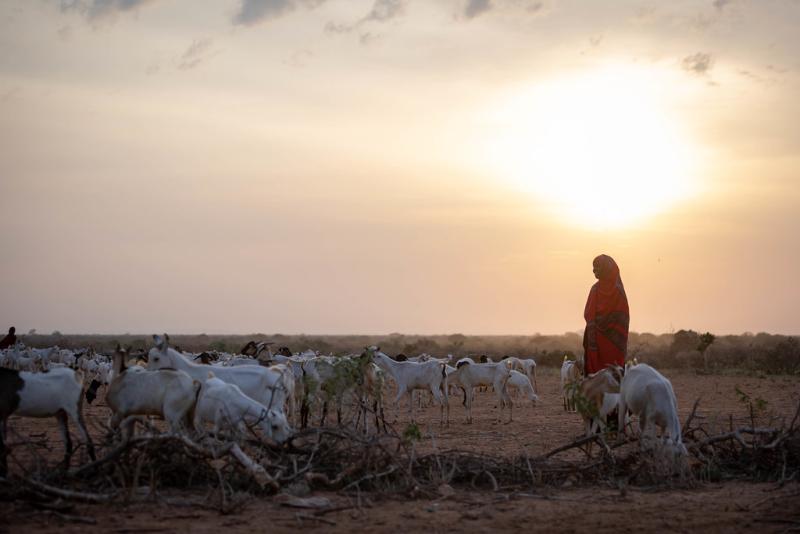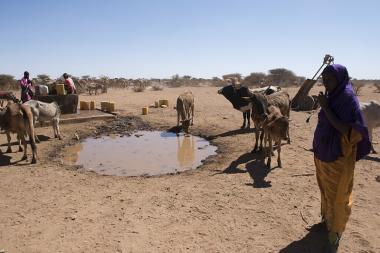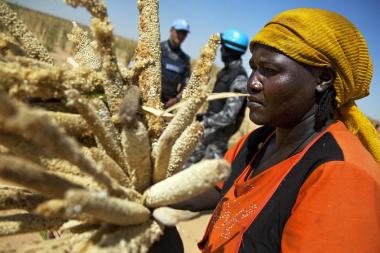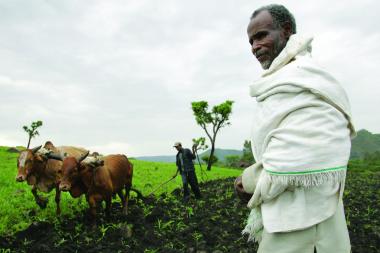Blog
What the case of Somalia can show us about financing climate action in conflict-affected countries
Somalia’s experiences can help us understand the obstacles which other conflict-affected countries face in terms of accessing and using climate finance – and how they can be overcome.
There is a critical gap in our understanding of how to advance climate finance and action in fragile and conflict-affected contexts.
People living in places affected by armed conflict, violence and instability are among the most vulnerable in the world to the adverse effects of climate change, because they lack the systems, services, and capacities they need to adapt to shocks. But while more than half of the 25 most climate-vulnerable countries are affected by armed conflict, violence and instability, they receive far less climate finance than more stable areas.
Remedying this conflict blind spot in climate finance is critical if the international community is serious about supporting the most climate-vulnerable people to build resilience in a changing climate.
As the world’s most climate-vulnerable country, Somalia’s experiences can help us understand the obstacles which other conflict-affected countries face in terms of accessing and using climate finance – and how they can be overcome.
Understanding the conflict blind spot
Like many conflict-affected countries, Somalia’s climate funds fall well below its stated needs. In 2021, the Government of Somalia judged its own climate finance needs to be around USD 5.5 billion per year. But according to estimates available from Climate Policy Initiative, climate finance inflows in 2019-2020 were only USD 321 million – which we calculate to be less than 0.6% of the amount required.
SPARC's research into Somalia has identified several obstacles to financing climate adaptation in conflict-affected countries. On the demand side, Somalia and other conflict-affected countries lack the capacity to absorb climate finance. Climate funds tend to flow to where they are most easily absorbed: that is, to countries that have the plans, institutional capacity and financial management needed to deploy this money effectively. But in conflict-affected states, existing adaptation policies tend to be poorly integrated with sectoral policies, or with a country’s long-term socioeconomic development vision. This is currently the case in Somalia, although the recently established Ministry of Environment and Climate Change is now embarking on ambitious plans to have more cohesive leadership, including a five-year strategic plan to enhance climate finance initiatives.
It is not just countries’ lack of capacity which prevents them from receiving more finance. There are also obstacles on the supply side. Climate funds and multilateral development banks are not set up to deal with conflict-affected countries: their rules and systems have all been developed for stable contexts, meaning they perceive risks in conflict contexts to be too high to fund climate adaptation, and neglect the risks that come from inaction. Their requirements for accreditation and project design are complex, time-consuming and resource-intensive– which may work for stable countries and high-capacity governments, but not for those countries like Somalia which have significant institutional and capacity constraints.
Vertical climate funds – i.e., official UNFCCC finance mechanisms, such as the Green Climate Fund and Adaptation Fund, which were set up to allocate resources to developing countries – are grant-based and therefore have a higher risk tolerance, which in theory should make them more capable of funding projects in low-capacity governments. And yet, of the USD 321 million of climate finance inflow which Somalia received from 2019-20, only 1% was provided by vertical climate funds. As of January 2023, Somalia had accessed only USD 51 million from vertical climate funds for national projects, and none at all from the Adaptation Fund.
Because of these difficulties, Somalia and other countries are highly dependent on multilateral agencies and international NGOs which are already accredited to vertical climate funds. But this presents additional challenges. Some agencies are overstretched on capacity and resources on the ground. Besides, they often engage based on their own institutional priorities and programming cycles, which do not necessarily build a coherent pathway towards climate-resilient development, as might be prioritised in the national development and climate policies. This is resulting in an opaque pipeline of adaptation projects and in duplication of efforts, at a time when Somalia is in urgent need of support.
Pathways out of fragility
Agreeing on a way forward to scale up climate finance to conflict-affected areas will be critical at COP28. Signatories to the Paris Agreement are currently negotiating a New Collective Quantified Goal on Climate Finance post-2025. While much disagreement exists between negotiating country blocs, the new goal needs to surpass the current commitment of USD 100 billion a year. This means that climate finance channelled through the vertical climate funds may increase from current levels in the future, heightening the importance for developing countries to gain access.
The COP28 Declaration on Climate, Relief, Recovery and Peace, which is due to be announced at the upcoming conference, marks an important step forward in talking about this issue. The Declaration, which appeals for “bolder collective action” to build climate resilience in countries affected by fragility and conflict, includes a call to continue scaling up finance to these areas, and to enhance the “predictability, flexibility, speed, and simplicity” of application, accreditation and procurement procedures.
More generally, the development system should focus on building the readiness of governments of fragile and conflict-affected countries, like Somalia, to accept and use climate finance. By improving thier capacity to absorb financial resources and ensuring that they have the right mechanisms in place, governments will be able to apply for and use climate finance directly, rather than only through international or multilateral financial intermediaries. We can already see this being done in Somalia, which is implementing wide-ranging reforms to help strengthen key economic and financial policy institutions. These reforms are also paving the way for Somalia to reach debt relief at the Heavily Indebted Poor Countries (HIPC) Completion Point in December 2023.
Finally, conversations at COP28 and beyond must continue to encourage bilateral and multilateral organisations and climate funds to rethink their risk appetite and approaches. This includes acknowledging the significant financial risks which investors face in conflict-affected countries. One solution may be to mitigate the risk of operating in conflict settings by incorporating conflict sensitivity into climate programming. By drawing on expertise from other sectors, including local and international humanitarian and peacebuilding actors, organisations and funds can reconsider whether issues that currently prohibit action – such as gaps in meteorological data or the presence of weapon bearers – really are insurmountable.
Perhaps the strongest argument to incentivise funding is to realise that inaction itself has a cost. Overly risk-averse approaches to climate finance effectively leave vulnerable communities in Somalia and elsewhere to bear the risk themselves, resulting in heightened humanitarian needs, and a potential exacerbation of tensions and development reversals across the region – all of which increases the costs of action. We must rethink the risks of financing climate action in conflict-affected countries, and realise that ultimately, the greatest risk lies not in the attempt itself, but in the failure to make it.
This piece was originally written for ODI. For the original version, please see here.

Early morning, Kahiya Hassen Nur leads her goats to find pasture in Kilway village, Afdher zone, in the drought-afflicted Somali region of Ethiopia, 2022
Credit Image by Mulugeta Ayene/UNICEF Ethiopia - CC BY-NC-ND 2.0 DEED


